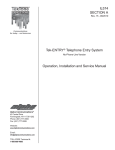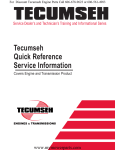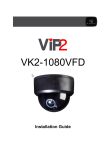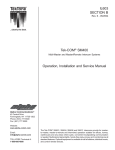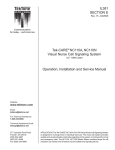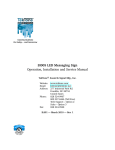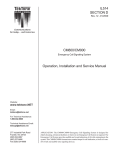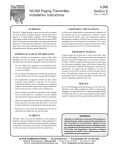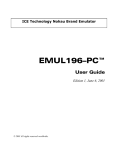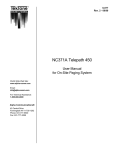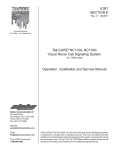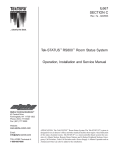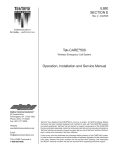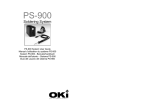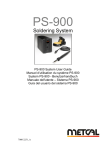Download Tek-ENTRY® Telephone Entry System
Transcript
IL573 SECTION A Rev. 12 - 12/2009 Tek-ENTRY® Telephone Entry System Phone-Line Version Operation, Installation and Service Manual Alpha Communications® 42 Central Drive Farmingdale, NY 11735-1202 Phone: (631) 777-5500 Fax: (631) 777-5599 Website: www.AlphaCommunications.com Email: [email protected] TOLL-FREE Technical #: 1-800-666-4800 Operation, Installation and Service Manual Copyright © 2002–2009 TekTone® Sound & Signal Mfg., Inc., All rights reserved. No part of this publication may be copied without the express written permission of TekTone® Sound & Signal Mfg., Inc. The content of this manual is furnished for informational use only, is subject to change without notice, and should not be construed as a commitment by TekTone® Sound & Signal Mfg., Inc. TekTone® Sound & Signal Mfg., Inc. assumes no responsibility or liability for any errors or inaccuracies that may appear in this documentation. TekTone, the TekTone logo, Tek-Call, Tek-Care, Tek-Check-In, Tek-Com, Tek-Digicare, Tek-Door, Tek-Entry III, Tek-Guard, TekMicro, Tek-Micro II, Tek-MMARS II, TekNIOS, TekNIOS II, Tek-Paging, Tek-Phone, Tek-Safe, Tek-Select II, Tek-Sentry, TekSound, Tek-Status, Tek-Trio and Tek-View are either registered trademarks or trademarks of TekTone® Sound & Signal Mfg., Inc. in the United States and/or other countries. All other trademarks are the property of their respective owners. ii • IL573 Tek-ENTRY® Telephone Entry System Phone-Line Version Manual Copyright © TekTone Sound & Signal Mfg., Inc. All Rights Reserved. Table of Contents ———————————————————— System Introduction ............................................................................... 1 General Features .......................................................................................................... 1 Special Features ........................................................................................................... 1 Postal Service Lock .............................................................................................. 1 Door Timer Cut-Off (Tailgate Prevention) ........................................................... 1 Fire Alarm (Emergency) Input ............................................................................. 1 Multiple Entrances ............................................................................................... 1 Night Service ........................................................................................................ 1 Wiegand Data Output ........................................................................................... 1 System Installation and Programming .................................................. 2 Installation Tips ........................................................................................................... 2 System Installation Step by Step ................................................................................. 2 System Programming and Settings .............................................................................. 5 Program Mode—Begin/End ................................................................................. 5 To Program Codes (Tenant Dial Codes) .............................................................. 5 View Suite Codes (Tenant Dial Codes) ................................................................ 6 Keyless Entry Codes ............................................................................................ 6 View Keyless Codes ............................................................................................. 6 New Master Code ................................................................................................. 6 7, 10 or 11 Digit Programming ............................................................................ 6 Pulse or Tone Dialing ........................................................................................... 7 Door Open Time ................................................................................................... 7 Talk Time ............................................................................................................. 7 Night Service (Guard Telephone) ........................................................................ 7 Rotary Phones ...................................................................................................... 7 Guard Telephone Number .................................................................................... 8 Erase/Reset to Factory Default ............................................................................. 8 Adjustments ............................................................................................................... 8 Volume Control .................................................................................................... 8 Rotary Phone Pulse Sensitivity ............................................................................ 8 Notice to U.S. Installers and Users .............................................................................. 9 Notice to Canadian Installers and Users .................................................................... 10 Illustrations Figure 1—System Wiring Diagram (TE903A, TE904, TE905A) ............................... 3 Figure 2—Hands-Free Panel Wiring Diagram ............................................................ 4 Figure 3—Handset Panel Wiring Diagram .................................................................. 4 Figure 4—PM900 Control Unit Mounting Template ................................................ 11 Figure 5—Frame and Housing Installation ............................................................... 12 Worksheets Programming Worksheet ........................................................................................... 13 Directory Worksheets .......................................................................................... 14–18 Tek-ENTRY® Telephone Entry System Operating Instructions ................................ 19 Copyright © TekTone Sound & Signal Mfg., Inc. All Rights Reserved. IL573 Tek-ENTRY® Telephone Entry System Phone-Line Version Manual • iii System Introduction ——————————————————— General Features Tek-ENTRY® Telephone Entry Systems are designed for easy operation and accommodate 1–750 suites with 7-, 10- or 11-digit phone numbers. The system has many sophisticated features built in, such as: • • • • • • • • • • All programming is done via the system keypad. EEPROM Memory retains programmed information during total power failure. Two programmable relay outputs control door strikes, gates, cameras, etc. System operates with both touchtone and rotary pulse phones. Automatic call termination after 8 seconds of dial tone detection. Microphone Mute prevents unauthorized entry using a tone generator. Variable tenant code length: 1, 2, 3 or 4 digits. One keyless entry code per tenant, plus five for use by building management. Tenant codes can be actual suite numbers or coded for security purposes. May be programmed with any combination of 7, 10 or 11 digit phone numbers. Special Features Postal Service Lock Provision for the installation of a postal service lock is available on the rear of the system enclosure’s control panel. Door Timer Cut-Off (Tailgate Prevention) This feature requires the installation of a “Normally Open” switch contact that closes when the entry door has been opened. A magnetic contact, as used in security systems, is acceptable for this application, provided that it is a “Normally Open” type. (Most security door contacts are of the “Normally Closed” type.) When the electric door strike is released, the door remains open for the period of time that has been programmed. When the door timer cut-off feature is used, the door strike de-energizes as soon as the system senses that the entry door has been opened. This causes the door to lock when it closes, regardless of the programmed time. The door strike is therefore energized only as long as necessary, to prevent unauthorized entry of individuals who follow behind the visitor (tailgating). Fire Alarm (Emergency) Input Connecting a “Normally Open” alarm contact from the building fire alarm system causes the electric door strike to pulse on and off in the event of a fire (emergency) situation. This effectively leaves the entry door unlocked for the duration of the emergency. Multiple Entrances Accommodating multiple entry doors is a built-in feature of the Tek-ENTRY® Telephone Entry Systems. Up to 20 entry systems can be interconnected without additional switching equipment, and all systems can be connected to one common telephone line. One additional pair of wires, parallel connected to terminals “ME” and “G” of all entry systems, is required. When one entry panel is in use, the other panels are temporarily disabled and display a “SYSTEM IN USE” message. (NOTE: Each entry panel must be independently powered and programmed, and requires a telephone extension jack at that location.) Night Service This feature redirects all entry system calls to a pre-designated telephone number (guard phone). When this feature is enabled (by entering “*456”), the entry system displays the “Night Service On” message. To return to normal operation, re-enter “*456”. Wiegand Data Output This feature connects the Tek-ENTRY® Telephone Entry System to a card access system with a Wiegand 26-bit input. When a tenant approves a visitor, the tenant’s code is sent to the card access system, causing the door to open. Copyright © TekTone Sound & Signal Mfg., Inc. All Rights Reserved. IL573 Tek-ENTRY® Telephone Entry System Phone-Line Version Manual • 1 System Installation and Programming –—————————— Installation Tips 1. Make arrangements with the telephone company to install a telephone line for use by the system. Install the telephone line jack inside the entry panel enclosure. When ordering, specify the equipment DOC approval number (1949 5264 A). 2. One 16 volt/20 VA UL® Listed and CSA approved class 2 power transformer is required for system operation. A second transformer is required for door strike activation. This transformer should have the necessary voltage and current rating for the door strike that is to be used (max. 28 volts, 3 amps). 3. Transformers and remote devices such as the door strike, fire alarm and door contacts must be wired to the system controller located in the enclosure housing. A wiring channel at the rear of the system enclosure must be provided for these devices. Follow local building code requirements for low voltage wiring. 4. If a postal service lock is to be installed, make arrangements with the local post office to supply the lock. 5. In multiple entrance applications, two additional wires are required from each entry system to interconnect the system controllers. A telephone line extension jack must also be installed at each entry location (see Figure 1—System Wiring Diagram). 6. Do not mount the entry panel in an area where it may be exposed to near-horizontal water or moisture sources, for example driving rain or water spray. System Installation Step by Step Refer to Figure 1—System Wiring Diagram for terminal locations. Also refer to Figure 2— Hands-Free Panel Wiring Diagram and Figure 3—Handset Panel Wiring Diagram. 1. Mount the system enclosure to the wall in the location closest to the building’s controlled entry point. (Refer to Figure 5—Frame and Housing Installation.) 2. Connect the door strike wires to terminals “D1” and “D2” if DC (silent) operation is desired, or to terminals “D3” and “D4” for AC (buzzing) operation. The maximum switched door strike load is 28 volts at 3 amps. 3. An auxiliary switched device (such as a parking gate) may be controlled through the auxiliary relay contact that is available by connecting to terminals “NC” (normally closed), “C” (common), and “NO” (normally open). The maximum switched auxiliary load is 28 volts at 3 amps. This contact will change to the energized state for one second when the tenant dials “6” from their DTMF (touchtone) telephone. 4. Terminal “PL” is for the postal service lock. Closing of a normally open switch between terminals “PL”and “G” is required for activation. The system is pre-wired for this service, but requires a lock to be installed on the rear of the system control panel (optional on TE905A). Remove the panel plug button for the postman’s key and remove the retaining strap on the switch actuator. Mount the lock with the supplied hardware. Adjust the switch actuator for proper operation with the lock. 5. Terminal “TC” is for connection of a door timer cut-off contact. A normally open contact that closes when the door has been opened will cut-off the door timer and instantly re-lock the door. This is used to prevent tailgating of unwanted visitors through the entry doors. Connect between terminals “TC” and “G.” 6. Terminal “FA” is for connection to the building fire alarm system. A normally open alarm contact that closes during an alarm condition can be connected between terminals “FA” and “G” to pulse open the entry door during a fire or other emergency. 2 • IL573 Tek-ENTRY® Telephone Entry System Phone-Line Version Manual Copyright © TekTone Sound & Signal Mfg., Inc. All Rights Reserved. Figure 1—System Wiring Diagram (TE903A, TE904, TE905A) Note: To battery backup door release, repeat this section on T3 and T4 connections. PK124 Battery Charger BA001 12V Battery C 4 AMP FUSE B BA001 12V Battery P T1 T2 SYSTEM POWER 16 VAC 20 VA DOOR STRIKE TRANSFORMER D.C. (SILENT) + DOOR STRIKE A.C. (BUZZING) DOOR STRIKE AUXILIARY RELAY MOMENTARY CONTACT NOTE: IF USING BATTERY HOOK-UP, DO NOT CONNECT T1 & T2 TO TRANSFORMER T1 T2 18 AWG T3 T4 120 VAC 18 AWG DOOR STRIKE TRANSFORMER MUST BE COMPATIBLE TO STRIKE D1 D2 D3 CONNECT DOOR STRIKE TO D.C. OR A.C. OUTPUTS. MAXIMUM OUTPUT IS 28V, 3AMP. DOOR STRIKE 18 AWG D4 NO C POSTAL LOCK N.O. SWITCH NC POSTAL LOCK PL DOOR TIMER CUTOFF TC COMMON G FIRE ALARM INPUT FA MULTIPLE ENTRANCE ME TELEPHONE LINE CONNECTIONS HARDWIRE TO TO "R" & "T" TERMINALS OR USE JACK 120 VAC 16 VAC N.O. SWITCH FIRE ALARM N.O. CONTACT MULTIPLE ENTRANCE TO NEXT TELEPHONE CONTROLLER SYSTEM. (G TO G & ME TO ME) R T D1 D0 G TO TELEPHONE LINE -OR- Wiegand Output Format: 26 bit Wiegand Voltage: 5 VDC Open Collector: No Pulse: 50 uSec. Duration: 1 mSec. TO TELEPHONE JACK Copyright © TekTone Sound & Signal Mfg., Inc. All Rights Reserved. IL573 Tek-ENTRY® Telephone Entry System Phone-Line Version Manual • 3 4 • IL573 Tek-ENTRY® Telephone Entry System Phone-Line Version Manual Copyright © TekTone Sound & Signal Mfg., Inc. All Rights Reserved. + - SP + M S Figure 2—Hands-Free Panel Wiring Diagram CONNECTOR POTENTIOMETER KEYPAD PCB MIC SP - + - + M S MIC - RED BLACK BROWN RED ORANGE YELLOW GREEN BLUE RED BLACK } NOT CONNECTED } NOT CONNECTED Figure 3—Handset Panel Wiring Diagram BLACK RED WHITE WHITE (Rear View) HANDSET PANEL System Installation and Programming 7. Terminal “ME” is the interconnect point for multiple entrance systems. Interconnect terminals “ME” and “G” of all entry systems to allow operation with a common telephone line. Each location must also be wired with its own transformer, door strike, extension telephone jack, switch contacts, etc., as shown on Figure 1—System Wiring Diagram. Each location must be programmed separately. 8. At this point, double-check all wiring for shorts and opens. 9. Connect door strike transformer to terminals “T3” and “T4.” The maximum door strike load that may switch through the controller is 28 volts at 3 amps. 10.Connect 16 VAC from the system transformer to terminals “T1” and “T2” on the system controller terminal block. (This transformer must not be used to power any other devices, such as the door strike.) The display will illuminate and the message “WELCOME…DIAL CODE NUMBER” will appear. 11.Connect the supplied telephone cord from the jack or terminals “R” and “T” on the system controller to the telephone line jack supplied by the telephone company. System Programming and Settings All programming of the entry system is accomplished through the use of the system keypad and the display located on the control panel. Use the supplied Tek-ENTRY® Telephone Entry System Directory Worksheets to generate a record of the building occupants, their suite numbers, telephone numbers, assigned dial codes, and keyless entry codes. These sheets will be required for programming, as well as when changes are to be made. Complete the Tek-ENTRY® Telephone Entry System Programming Worksheet, and ensure that it, the Tek-ENTRY® Telephone Entry System Directory Worksheets and the User Operating Instructions are given to building management when installation and programming are complete. Program Mode—Begin/End Enter “*” and the three-digit master code (default is *123) to begin a programming session. Use the “1” key on the keypad to scroll up the programming menu and the “3” key to scroll down. When the desired function is displayed on the screen, press the “#” key to select it. Follow the displayed instructions to make the necessary changes. When programming is complete, end program mode by pressing the “*” key twice. To Program Codes (Tenant Dial Codes) Tenant dial codes are used at the entrance panel to call a tenant, and are usually listed on a tenants directory. Suite numbers may be used as tenant dial codes, if desired. To program tenant dial codes and their corresponding telephone numbers into the system: 1. When the programming menu displays “TO PROGRAM CODES,” press the “#” key. 2. Enter the 4-digit tenant dial code, and then the tenant’s telephone number. Press the “#” key to save. Continue in this fashion until all tenant dial codes and telephone numbers have been entered. If a tenant dial code is fewer than 4 digits in length, enter zeros as leading digits. The leading zeros are not needed during actual use, but are required during programming. If an error is made when entering a tenant dial code or telephone number, press the “*” key to backspace. 3. Press the “*” key to return to the programming menu. 4. If desired, press the “*” key to end program mode. Copyright © TekTone Sound & Signal Mfg., Inc. All Rights Reserved. IL573 Tek-ENTRY® Telephone Entry System Phone-Line Version Manual • 5 System Installation and Programming View Suite Codes (Tenant Dial Codes) Use this function to review and/or delete tenant dial codes and telephone numbers 1. When the programming menu displays “VIEW SUITE CODES,” press the “#” key. The message “CODE TO REVIEW, _______” will appear. 2. Enter the four-digit tenant dial code to be reviewed. The dial code and associated telephone number will be displayed. 3. To delete the displayed tenant dial code and telephone number, press the “#” key. 4. To view all tenant dial codes and telephone numbers, use the “1” key to scroll up, and the “3” key to scroll down. 5. Press the “*” key to return to the programming menu. 6. If desired, press the “*” key to end program mode. Keyless Entry Codes Keyless entry codes allow tenants to enter through the controlled doors using a four-digit code from the system keypad, rather than a key. During actual use, this code must be preceded by the “#” key so that the code is not visible on the display. For security, assign each tenant a unique keyless entry code, and do not duplicate any suite numbers or tenant dial codes. 1. When the programming menu displays “ENTER KEYLESS CODES,” press the “#” key. The message “KEYLESS ENTRY CODE #____” will appear. 2. Enter a four-digit code and press the “#” key to save. Continue entering keyless entry codes until all are entered. 3. Press the “*” key to return to the programming menu. 4. If desired, press the “*” key to end program mode. View Keyless Codes This section allows the review and/or deletion of keyless entry codes. 1. When the programming menu displays “VIEW KEYLESS CODES,” press the “#” key. The message “CODE TO REVIEW _____” will appear. 2. Enter the four-digit keyless entry code to be reviewed. The keyless entry code will be displayed. 3. To delete the displayed keyless entry code, press the “#” key. 4. To view all keyless entry codes, use the “1” key to scroll up, and the “3” key to scroll down. 5. Press the “*” key to return to the programming menu. 6. If desired, press the “*” key to end program mode. New Master Code The master code is used to access the program mode. When the entry system is shipped from the factory, its master code is set to “*123.” It is advisable to change the master code and record the new code in the appropriate place on the Tek-ENTRY® Telephone Entry System Programming Worksheet. The master code is used by the installation company or by authorized personnel, only when programming is necessary. To change the master code: 1. When the programming menu displays “NEW MASTER CODE,” press the “#” key. The message “MASTER CODE *123” will appear. 2. Enter a new three-digit master code and press the “#” key to save. 3. Press the “*” key to return to the programming menu. 4. If desired, press the “*” key to end program mode. 7-, 10- or 11-Digit Programming This function changes the phone number length that the system expects when Tenant Dial Codes are being programmed. Factory default is 7-digit phone numbers. Any combination of 7-, 10- and 11-digit phone numbers may be programmed: program all the 6 • IL573 Tek-ENTRY® Telephone Entry System Phone-Line Version Manual Copyright © TekTone Sound & Signal Mfg., Inc. All Rights Reserved. System Installation and Programming 7-digit phone numbers, then change this setting to 10- or 11-digit phone numbers and program those numbers. 1. When the programming menu displays “7, 10 OR 11 DIGITS?, ” press the “#” key. The message “TYPE 07, 10 OR 11 DIGITS” will appear. 2. Enter “07” to program 7-digit numbers; enter “10” to program 10-digit numbers; or enter “11” to program 11-digit numbers. Press the “#” key to save. 3. Press the “*” key to return to the programming menu. 4. If desired, press the “*” key to end program mode. Pulse or Tone Dialing This item selects the type of dialing used by the system controller—DTMF (touchtone) or pulse. Factory default is DTMF. The setting must correspond to the type of telephone line that has been installed for the entry system. 1. When the programming menu displays “PULSE OR TONE,” press the “#” key. The message “PULSE OR TONE” will appear. 2. Enter “00” for Pulse (Rotary) dialing; or enter “11” for Tone (DTMF) dialing. Press the “#” key to save. 3. Press the “*” key to return to the programming menu. 4. If desired, press the “*” key to end program mode. Door Open Time The door open time can be reprogrammed to 0-99 seconds to prevent tailgating. Factory default is 10 seconds. See Door Timer Cut-Off in the System Introduction—Special Features section for more information. 1. When the programming menu displays “DOOR TIME,” press the “#” key. The message “DOOR OPEN TIME” will appear. 2. Enter a two-digit time in seconds and press the “#” key to save. 3. Press the “*” key to return to the programming menu. 4. If desired, press the “*” key to end program mode. Talk Time Talk time can be reprogrammed to 0-99 seconds to set the maximum conversation length between a visitor and tenant. (Note: Talk time starts when visitor dials tenant.) Factory default is 60 seconds. 1. When the programming menu displays “TALK TIME,” press the “#” key. The message “TALK TIME” will appear. 2. Enter a two-digit time in seconds and press the “#” key to save. 3. Press the “*” key to return to the programming menu. 4. If desired, press the “*” key to end program mode. Night Service (Guard Telephone) When enabled, the night service on feature redirects all entry system calls to the guard telephone. Factory default is “disabled.” See Night Service in the System Introduction— Special Features section for more information. 1. When the programming menu displays “NIGHT SERVICE?,” press the “#” key. The message “ENABLE/DISABLE” will appear. 2. Enter “00” to enable night service; or enter “11” to disable night service. Press the “#” key to save. 3. Press the “*” key to return to the programming menu. 4. If desired, press the “*” key to end program mode. Rotary Phones When rotary phone use is enabled, tenants may use either rotary (pulse) or touchtone phones with the system. When disabled, tenants may use only touchtone phones. Factory default is “disabled.” Copyright © TekTone Sound & Signal Mfg., Inc. All Rights Reserved. IL573 Tek-ENTRY® Telephone Entry System Phone-Line Version Manual • 7 System Installation and Programming 1. When the programming menu displays “ROTARY PHONES?,” press the # key. The message “ENABLE/DISABLE” will appear. 2. Enter “00” to enable rotary phone use; or enter “11” to disable rotary phone use. Press the “#” key to save. 3. Press the “*” key to return to the programming menu. 4. If desired, press the “*” key to end program mode. Guard Telephone Number This is the telephone number that all calls will be routed to when night service is enabled. See Night Service in the System Introduction—Special Features section for more information. 1. When the programming menu displays “GUARD PHONE,” press the “#” key. The message “GUARD PHONE NO.” will appear. 2. Enter a telephone number and press the “#” key to save. 3. Press the “*” key to return to the programming menu. 4. If desired, press the “*” key to end program mode. Erase/Reset to Factory Default This function erases all programming, including Tenant Dial Codes and Keyless Entry Codes, and returns the system to factory defaults. 1. When the programming menu displays “ERASE/RESET TO FACTORY DEFAULT,” press the “#” key. The message “ARE YOU SURE? *=NO #=YES” will appear. 2. Enter “*” to retain system programming; or enter “#” to erase all programming and return to factory defaults. 3. Press the “*” key to return to the programming menu. 4. If desired, press the “*” key to end program mode. Adjustments Volume Control The communication volume levels are factory preset for normal operations. The levels can be increased or decreased by adjusting the potentiometers located along the bottom of the system controller, behind the front display plate. Audio level from the entry system to the suite is controlled by the MICROPHONE VOLUME control. Audio level from the suite to the entry system is controlled by the SPEAKER VOLUME control. Rotary Phone Pulse Sensitivity Telephone companies do not specify or guarantee the waveshape of the signal transmitted when the tenant dials the digit “9” from a rotary (pulse) telephone. In order to achieve best results, Tek-ENTRY® Telephone Entry Systems are furnished with a sensitivity adjustment potentiometer, as well as an indicator lamp to view the incoming rotary signal (pulses). This potentiometer is labeled PULSE SENSITIVITY on the system controller. The pulse sensitivity is factory preset so that a wide range of incoming rotary signals will properly trigger the door circuit, and so will usually not require adjustment. If adjustment is necessary because the door strike cannot be properly triggered, use the following procedure. 1. Set the PULSE SENSITIVITY control to the middle position. 2. From the entry system, call the suite telephone that is not triggering the door circuit. 3. Observe the PULSE INDICATOR while the digit “9” is being dialed from the suite telephone. The indicator should flash distinctly every time a pulse is heard. 4. If the indicator barely comes on, the sensitivity is set too low. Increase the sensitivity by turning the shaft of the potentiometer clockwise 1/8th of a turn at a time until the indicator shows distinct flashing. 8 • IL573 Tek-ENTRY® Telephone Entry System Phone-Line Version Manual Copyright © TekTone Sound & Signal Mfg., Inc. All Rights Reserved. System Installation and Programming 5. If the indicator is on steadily, the sensitivity is set too high and the door circuit may false trigger. Turn the shaft of the potentiometer counter-clockwise to decrease the sensitivity. The sensitivity may also require reduction if the phone line is particularly loud or noisy. NOTE: Sensitivity adjustments are not required when using DTMF (touchtone) suite telephones. Notice to U.S. Installers and Users Incidence of Harm Should terminal equipment or protective circuitry cause harm to the telephone network, the telephone company shall, where practical, notify the customer that temporary discontinuance of service may be required; however, where prior notices are not practical, the telephone company may temporarily discontinue service if such action is deemed reasonable in the circumstances. In the case of such temporary discontinuance, the telephone company shall promptly notify the customer, who will be given the right to bring a complaint to the FCC if he feels the disconnection is not warranted. Changes in the Telephone Company Equipment or Facilities The telephone company may make changes in its communications facilities, equipment, operations or procedures, where such action is reasonably required and proper in its business. Should any such changes render the customer’s terminal equipment incompatible with the telephone company facilities, the customer shall be given adequate notice to make modifications to maintain uninterrupted service. General The FCC prohibits customer-provided terminal equipment to be connected to party lines or to be used in conjunction with coin telephone service. The Tek-ENTRY® Telephone Entry System is equipped with a USOC RJ11C standard miniature modular jack that is designed to plug directly into a modular jack. Notification to the Telephone Company Notification to the telephone company is no longer required prior to connecting the registered equipment; but upon request from the telephone company, the user shall tell the telephone company which line the equipment is connected to, as well as the registration number and ringer equivalence of the registered protective circuitry. In most, but not all areas, the sum of all REN’s should be 5.0 or less. Malfunction of the Equipment In the event that the Tek-ENTRY® Telephone Entry System should fail to operate properly, the customer shall disconnect the equipment from the telephone line to determine if it is the customer’s equipment that is not working properly. If the problem is with the system equipment, the user shall discontinue use until it is repaired. In the event service is needed, the user should contact the local TekTone® representative. Telephone Connections Requirement Except for telephone company provided ringers, all connections to the telephone network shall be made through standard plugs and standard telephone company provided jacks, or equivalent, in such manner as to allow for easy and immediate disconnection of the terminal equipment. Standard jacks shall be arranged so that if the plug connected thereto is withdrawn, no interference to the operation of the equipment at the customer’s premises—which remains connected to the telephone network—shall occur by reason of such removal. FCC Notice This equipment generates and uses radio frequency energy and if not installed and used in strict accordance with the instructions listed in this Operation, Installation and Service Manual, interference to radio and television reception may occur. Copyright © TekTone Sound & Signal Mfg., Inc. All Rights Reserved. IL573 Tek-ENTRY® Telephone Entry System Phone-Line Version Manual • 9 System Installation and Programming It has been tested and found to comply with the limits for a “Class B Computing Device,” in accordance with the specifications in “Subpart B of Part 15” of the FCC rules. These rules are designed to provide reasonable protection against such interference in a residential installation. If this equipment does cause interference to radio or television reception— which can be determined by turning off the equipment to see if the interference stops— the user is encouraged to try and correct the interference by one or more of the following measures: 1. Reorient the receiving antenna. 2. Relocate the Tek-ENTRY® Telephone Entry System with respect to the radio or television. 3. Plug the Tek-ENTRY® Telephone Entry System into a different outlet, so that the system and the radio or television are on different circuits. NOTE: The manufacturer is not responsible for any radio or television interference caused by unauthorized modifications to this equipment. Such modifications could void the user’s authority to operate the equipment. Notice to Canadian Installers and Users Notice The Canadian Department of Communications label identifies certified equipment. This certification means that the equipment meets certain telecommunications network protective, operational and safety requirements. The Department does not guarantee the equipment will operate to the user’s satisfaction. Before installing this equipment, users should ensure that it is permissible to be connected to the facilities of the local telecommunications company. The equipment must also be installed using an acceptable method of connection. The customer should be aware that compliance with the above conditions may not prevent degradation of service in some situations. Repairs to certified equipment should be made by an authorized facility designated by the supplier. Any repairs or alterations made by the user of this equipment, or equipment malfunctions, may give the telecommunications company cause to request the user to disconnect the equipment. In the event service is needed, the user should contact TekTone® Sound & Signal Mfg., Inc. Caution Users should ensure, for their own protection, that the electrical ground connections of the power utility, telephone lines, and internal metallic water pipe system, if present, are connected together. This precaution may be particularly important in rural areas. Users should not attempt to make such connections themselves, but should contact an appropriate electric inspection authority or electrician. Load Number The Load Number (LN) assigned to each terminal device denotes the percentage of the total load to be connected to a telephone loop, which is used by the device, to prevent overloading. The termination on a loop may consist of any combination of devices, subject only to the requirements that the sum of the Load Numbers of all of the devices does not exceed 100. 10 • IL573 Tek-ENTRY® Telephone Entry System Phone-Line Version Manual Copyright © TekTone Sound & Signal Mfg., Inc. All Rights Reserved. Drill Here Drill Here Copyright © TekTone Sound & Signal Mfg., Inc. All Rights Reserved. THIS EDGE TO SIDE OF HOUSING THIS EDGE TO SIDE OF HOUSING THIS EDGE TO SIDE OF HOUSING Figure 4—PM900 Control Unit Mounting Template IL573 Tek-ENTRY® Telephone Entry System Phone-Line Version Manual • 11 Figure 5—Frame and Housing Installation OH192 Housing OF192 Frame Frame Bracket TE905A Vandal Resistant Screws AM190D Directory TE Series Master Housing & Frame Chart FRAMES Model# OF191 OF192 OF193 OF194 OF195 OF196 Width 6-1/4" 10 1/4" 14-1/4" 18-1/4" 22-1/4" 26-1/4" Wall Cut-out - FLUSH MOUNT HOUSING Model # OH191 OH192 OH193 OH194 OH195 OH196 Width Overall 4-3/8" 8-3/8" 12-3/8" 16-3/8" 20-3/8" 24-3/8" Wall Cut-out 4-1/2" 8-1/2" 12-1/2" 16-1/2" 20-1/2" 24-1/2" Height Overall 17-1/8" 17-1/8" 17-1/8" 17-1/8" 17-1/8" 17-1/8" Wall Cut-out 17-1/4" 17-1/4" 17-1/4" 17-1/4" 17-1/4" 17-1/4" Depth 3-1/2" 3-1/2" 3-1/2" 3-1/2" 3-1/2" 3-1/2" For more than 240 suites, contact factory for frame and housing information. Directories supplied separately. Notes: 1. Refer to frame and housing chart for wall cut-out dimensions. 2. AM190D directory panels have 60 name capacity. For additional directories, size the frame and housing accordingly. (Example: 1-TE905A + 2-AM190D would require an OF/OH193, 1-TE905A+3AM190D would require an OF/OH194, 1-TE905A+0-AM190D would require an OF/OH191.) 3. Flush mounting frame shown in diagram above. 4. Frame bracket supplied with OF192. Bracket is supplied with scrulox screws, but it is suggested you use the spanner type vandal-resistant screws supplied with the TE905A. Use TekTone® driver #HT007. 5. Refer to Figure 4—PM900 Control Unit Mounting Template to mount the PM900 Control Unit inside the housing. 12 • IL573 Tek-ENTRY® Telephone Entry System Phone-Line Version Manual Copyright © TekTone Sound & Signal Mfg., Inc. All Rights Reserved. Programming Worksheet ————————————————– Building Address: ______________________________________________________________________ ______________________________________________________________________ Date of Installation: ______________________ System Telephone Line #: _____________________ Installation Company: ______________________________________________________________________ ______________________________________________________________________ Programming Instructions: A. Enter “*” and the three-digit Master Code (see #3 below) on the keypad to access the programming menu. B. Press the “1” key to scroll up, or press the “3” key to scroll down the menu screen to the desired function. C. Press the “#” key to select the desired function when it is displayed on the screen. D. Follow the displayed instructions to make the necessary changes. E. Press the “*” key twice to end program mode. Factory Default Programming: Function Factory Default Programmed 1. Tenant Dial Codes Blank (4 digits) See Directory Worksheet 2. Keyless Entry Codes Blank (4 digits) See Directory Worksheet 3. Master Code *123 * __ __ __ 4. 7-, 10- or 11-Digit Programming 7 digits ______________________ 5. Pulse or Tone Dialing DTMF (Tone) ______________________ 6. Door Open Time 10 Seconds __ __ (0-99 sec) 7. Talk Time 60 Seconds __ __ (0–99 sec) 8. Night Service Disabled ______________________ 9. Rotary Phones Disabled __ __ __ 10. Guard Telephone Number Blank __ ( __ __ __ ) __ __ __ – __ __ __ __ Copyright © TekTone Sound & Signal Mfg., Inc. All Rights Reserved. IL573 Tek-ENTRY® Telephone Entry System Phone-Line Version Manual • 13 Tek-ENTRY® Telephone Entry System Directory Worksheet — Suite # Tenant Name Telephone # 14 • IL573 Tek-ENTRY® Telephone Entry System Phone-Line Version Manual Tenant Dial Code Keyless Entry Code Copyright © TekTone Sound & Signal Mfg., Inc. All Rights Reserved. Tek-ENTRY® Telephone Entry System Directory Worksheet — Suite # Tenant Name Copyright © TekTone Sound & Signal Mfg., Inc. All Rights Reserved. Telephone # Tenant Dial Code Keyless Entry Code IL573 Tek-ENTRY® Telephone Entry System Phone-Line Version Manual • 15 Tek-ENTRY® Telephone Entry System Directory Worksheet — Suite # Tenant Name Telephone # 16 • IL573 Tek-ENTRY® Telephone Entry System Phone-Line Version Manual Tenant Dial Code Keyless Entry Code Copyright © TekTone Sound & Signal Mfg., Inc. All Rights Reserved. Tek-ENTRY® Telephone Entry System Directory Worksheet — Suite # Tenant Name Copyright © TekTone Sound & Signal Mfg., Inc. All Rights Reserved. Telephone # Tenant Dial Code Keyless Entry Code IL573 Tek-ENTRY® Telephone Entry System Phone-Line Version Manual • 17 Tek-ENTRY® Telephone Entry System Directory Worksheet — Suite # Tenant Name Telephone # 18 • IL573 Tek-ENTRY® Telephone Entry System Phone-Line Version Manual Tenant Dial Code Keyless Entry Code Copyright © TekTone Sound & Signal Mfg., Inc. All Rights Reserved. Tek-ENTRY® Telephone Entry System Operating Instructions A TekTone® Tek-ENTRY® Telephone Entry System has been installed in your building to provide increased security for yourself and your family. The system provides communication and entry control using your telephone. Your visitor will find your name and assigned dial code number on the directory near the TekENTRY® Telephone Entry System. When the visitor enters your dial code number, the Tek-ENTRY® Telephone Entry System will automatically ring your suite. You can answer from any telephone. Answer the call and establish the identity of your visitor. The call will automatically cut off after a preprogrammed time period. If you want to allow your visitor to enter, simply dial or press “9” on your telephone. This will unlock the entrance to your building or complex. You will hear a tone indicating the lock has been released. After hearing the tone, you may hang up. To deny entry, simply hang up. Do not dial “9.” If you are on the phone when a visitor calls you from the Tek-ENTRY® Telephone Entry System, they will get a busy signal unless you have “call waiting” service assigned to your telephone. Optional Entry Code Use If the box below is filled in, you have been assigned your own entry code. Entering this code on the Tek-ENTRY® Telephone Entry System keypad will allow you to enter the building without a key. When using this code, it is not necessary to pick up the handset. Press the “#” key, and then the four-digit number. Your code will not appear on the display. # Sound & Signal Mfg., Inc. Copyright © TekTone Sound & Signal Mfg., Inc. All Rights Reserved. IL573 Tek-ENTRY® Telephone Entry System Phone-Line Version Manual • 19
























